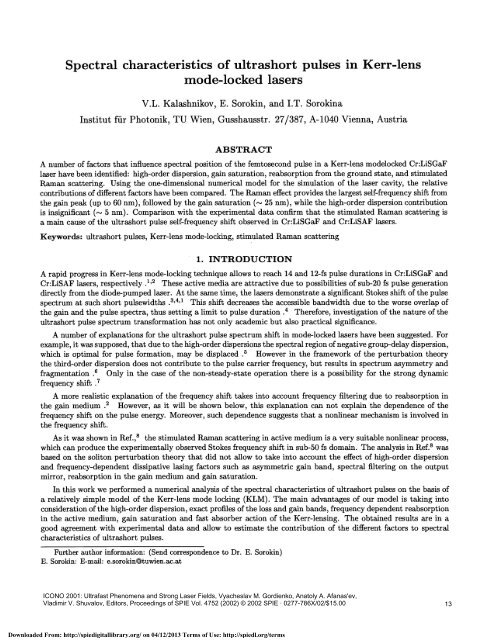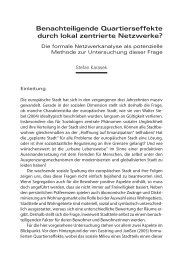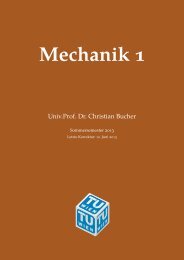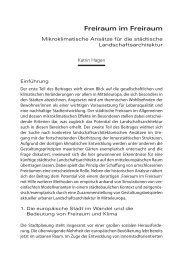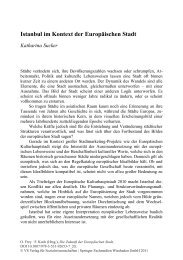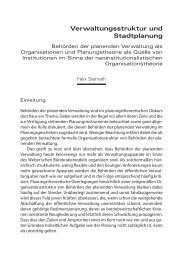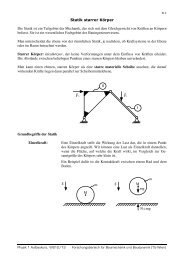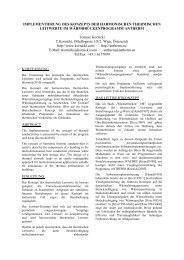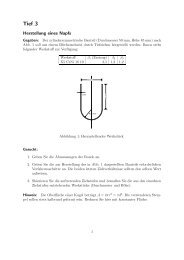Spectral characteristics of ultrashort pulses in Kerr-lens - TU Wien
Spectral characteristics of ultrashort pulses in Kerr-lens - TU Wien
Spectral characteristics of ultrashort pulses in Kerr-lens - TU Wien
Create successful ePaper yourself
Turn your PDF publications into a flip-book with our unique Google optimized e-Paper software.
<strong>Spectral</strong> <strong>characteristics</strong> <strong>of</strong> <strong>ultrashort</strong> <strong>pulses</strong> <strong>in</strong> <strong>Kerr</strong>-<strong>lens</strong><br />
mode-locked lasers<br />
V.L. Kalashnikov, E. Sorok<strong>in</strong>, and I.T. Sorok<strong>in</strong>a<br />
Institut für Photonik, <strong>TU</strong> <strong>Wien</strong>, Gusshausstr. 27/387, A-1040 Vienna, Austria<br />
ABSTRACT<br />
A number <strong>of</strong> factors that <strong>in</strong>fluence spectral position <strong>of</strong> the femtosecond pulse <strong>in</strong> a <strong>Kerr</strong>-<strong>lens</strong> modelocked Cr:LiSGaF<br />
laser have been identified: high-order dispersion, ga<strong>in</strong> saturation, reabsorption from the ground state, and stimulated<br />
Raman scatter<strong>in</strong>g. Us<strong>in</strong>g the one-dimensional numerical model for the simulation <strong>of</strong> the laser cavity, the relative<br />
contributions <strong>of</strong> different factors have been compared. The Raman effect provides the largest self-frequency shift from<br />
the ga<strong>in</strong> peak (up to 60 nm), followed by the ga<strong>in</strong> saturation (r' 25 nm), while the high-order dispersion contribution<br />
is <strong>in</strong>significant (f.%/ 5 nm). Comparison with the experimental data confirm that the stimulated Raman scatter<strong>in</strong>g is<br />
a ma<strong>in</strong> cause <strong>of</strong> the <strong>ultrashort</strong> pulse self-frequency shift observed <strong>in</strong> Cr:LiSGaF and Cr:LiSAF lasers.<br />
Keywords: <strong>ultrashort</strong> <strong>pulses</strong>, <strong>Kerr</strong>-<strong>lens</strong> mode-lock<strong>in</strong>g, stimulated Raman scatter<strong>in</strong>g<br />
1. INTRODUCTION<br />
A rapid progress <strong>in</strong> <strong>Kerr</strong>-<strong>lens</strong> mode-lock<strong>in</strong>g technique allows to reach 14 and 12-fs pulse durations <strong>in</strong> Cr:LiSGaF and<br />
Cr:LiSAF lasers, respectively •1,2 These active media are attractive due to possibilities <strong>of</strong> sub-20 fs pulse generation<br />
directly from the diode-pumped laser. At the same time, the lasers demonstrate a significant Stokes shift <strong>of</strong> the pulse<br />
spectrum at such short pulsewidths 3,4,1 This shift decreases the accessible bandwidth due to the worse overlap <strong>of</strong><br />
the ga<strong>in</strong> and the pulse spectra, thus sett<strong>in</strong>g a limit to pulse duration .' Therefore, <strong>in</strong>vestigation <strong>of</strong> the nature <strong>of</strong> the<br />
<strong>ultrashort</strong> pulse spectrum transformation has not only academic but also practical significance.<br />
A number <strong>of</strong> explanations for the <strong>ultrashort</strong> pulse spectrum shift <strong>in</strong> mode-locked lasers have been suggested. For<br />
example, it was supposed, that due to the high-order dispersions the spectral region <strong>of</strong> negative group-delay dispersion,<br />
which is optimal for pulse formation, may be displaced . However <strong>in</strong> the framework <strong>of</strong> the perturbation theory<br />
the third-order dispersion does not contribute to the pulse carrier frequency, but results <strong>in</strong> spectrum asymmetry and<br />
fragmentation 6 Only <strong>in</strong> the case <strong>of</strong> the non-steady-state operation there is a possibility for the strong dynamic<br />
frequency shift .<br />
A more realistic explanation <strong>of</strong> the frequency shift takes <strong>in</strong>to account frequency filter<strong>in</strong>g due to reabsorption <strong>in</strong><br />
the ga<strong>in</strong> medium 2 However, as it will be shown below, this explanation can not expla<strong>in</strong> the dependence <strong>of</strong> the<br />
frequency shift on the pulse energy. Moreover, such dependence suggests that a nonl<strong>in</strong>ear mechanism is <strong>in</strong>volved <strong>in</strong><br />
the frequency shift.<br />
As it was shown <strong>in</strong> Ref.,8 the stimulated Raman scatter<strong>in</strong>g <strong>in</strong> active medium is a very suitable nonl<strong>in</strong>ear process,<br />
which can produce the experimentally observed Stokes frequency shift <strong>in</strong> sub-50 fs doma<strong>in</strong>. The analysis <strong>in</strong> Ref.8 was<br />
based on the soliton perturbation theory that did not allow to take <strong>in</strong>to account the effect <strong>of</strong> high-order dispersion<br />
and frequency-dependent dissipative las<strong>in</strong>g factors such as asymmetric ga<strong>in</strong> band, spectral filter<strong>in</strong>g on the output<br />
mirror, reabsorption <strong>in</strong> the ga<strong>in</strong> medium and ga<strong>in</strong> saturation.<br />
In this work we performed a numerical analysis <strong>of</strong> the spectral <strong>characteristics</strong> <strong>of</strong> <strong>ultrashort</strong> <strong>pulses</strong> on the basis <strong>of</strong><br />
a relatively simple model <strong>of</strong> the <strong>Kerr</strong>-<strong>lens</strong> mode lock<strong>in</strong>g (KLM). The ma<strong>in</strong> advantages <strong>of</strong> our model is tak<strong>in</strong>g <strong>in</strong>to<br />
consideration <strong>of</strong> the high-order dispersion, exact pr<strong>of</strong>iles <strong>of</strong> the loss and ga<strong>in</strong> bands, frequency dependent reabsorption<br />
<strong>in</strong> the active medium, ga<strong>in</strong> saturation and fast absorber action <strong>of</strong> the <strong>Kerr</strong>-<strong>lens</strong><strong>in</strong>g. The obta<strong>in</strong>ed results are <strong>in</strong> a<br />
good agreement with experimental data and allow to estimate the contribution <strong>of</strong> the different factors to spectral<br />
<strong>characteristics</strong> <strong>of</strong> <strong>ultrashort</strong> <strong>pulses</strong>.<br />
Further author <strong>in</strong>formation: (Send correspondence to Dr. B. Sorok<strong>in</strong>)<br />
B. Sorok<strong>in</strong>: B-mail: e.sorok<strong>in</strong>©tuwien.ac.at<br />
ICONO 2001: Ultrafast Phenomena and Strong Laser Fields, Vyacheslav M. Gordienko, Anatoly A. Afanas'ev,<br />
Vladimir V. Shuvalov, Editors, Proceed<strong>in</strong>gs <strong>of</strong> SPIE Vol. 4752 (2002) © 2002 SPIE · 0277-786X/02/$15.00 13<br />
Downloaded From: http://spiedigitallibrary.org/ on 04/12/2013 Terms <strong>of</strong> Use: http://spiedl.org/terms
HRorCM3 CrLiSGaF HR<br />
CM1<br />
CM2<br />
Figure 1 . General scheme <strong>of</strong> a KLM Cr:LiSGaF laser used <strong>in</strong> this paper. This scheme directly corresponds to the<br />
experiments <strong>in</strong> Refs.1'3 HR, high reflector. CM, chirped mirror. OC, output coupler.<br />
The paper is organized as follows: first a summary <strong>of</strong> relevant measurements and experimental results is given,<br />
followed by the construction <strong>of</strong> the analytical and computational models. We then present the results <strong>of</strong> our calculations<br />
and discuss the <strong>in</strong>fluence <strong>of</strong> each <strong>of</strong> the abovementioned factors separately. F<strong>in</strong>ally, we present the results <strong>of</strong><br />
simulation with all factors <strong>in</strong>cluded, us<strong>in</strong>g distributed and discrete-element models.<br />
2. EXPERIMENTAL OBSERVATIONS<br />
Systematic Stokes shift <strong>of</strong> the <strong>ultrashort</strong> modelocked pulse <strong>in</strong> Cr:LiSGaF- and Cr:LiSAF-based KLM oscillators has<br />
been first reported <strong>in</strong> 1997 ,1,3,9 where the stimulated Raman scatter<strong>in</strong>g has been suggested as a possible mechanism.<br />
It has been found, that i) the shift could be observed <strong>in</strong> oscillators with different dispersion <strong>characteristics</strong>, ii) the<br />
shift <strong>in</strong>creases with the pulse energy, and iii) the shift <strong>in</strong>creases with pulse shorten<strong>in</strong>g. At pulse durations below 20<br />
fs, the peak <strong>of</strong> the pulse spectrum may shift as far as 50-70 nm <strong>in</strong>to the <strong>in</strong>frared as compared to the cw wavelength or<br />
modelocked spectrum at long pulse durations (r.'840 nm <strong>in</strong> Cr:LiSGaF) .' Later, analogous shifts <strong>in</strong> Cr:LiSAF have<br />
been reported by Uemura and ka2 and R. Gäbel et al All mentioned experiments used the common optical<br />
scheme, differ<strong>in</strong>g only <strong>in</strong> pump arrangements and dispersion compensation techniques. The schematic diagram <strong>of</strong><br />
the laser oscillator is shown <strong>in</strong> Fig. 1.<br />
This is a representative scheme for any X-shaped KLM laser, because<br />
different types <strong>of</strong> dispersion compensation can always be represented by lumped dispersion <strong>of</strong> a chirped mirror. For<br />
model<strong>in</strong>g purposes we used the parameters <strong>of</strong> experiments, reported <strong>in</strong> Refs.1'9: the Brewster-angled 4 mm long<br />
LiSGaF crystal doped with 1.4% Cr, beam diameter <strong>in</strong> Cr:LiSGaF crystal 40x60 pm. The high reflectors (HR) had<br />
negligible dispersion. The dispersion <strong>of</strong> the chirped mirrors (CM) has been calculated from its orig<strong>in</strong>al design, and<br />
additionally measured by white-light <strong>in</strong>terferometry. The <strong>in</strong>tracavity dispersion was calculated us<strong>in</strong>g the dispersion<br />
data <strong>of</strong> Cr:LiSGaF , measured dispersion curves <strong>of</strong> the chirped mirrors and calculated dispersion <strong>of</strong> the output<br />
coupler (Fig. 2). We also used the experimental loss spectra (mirror transmission and ground-state absorption <strong>in</strong><br />
Cr:LiSGaF) as shown <strong>in</strong> Fig. 3.<br />
The laser was pumped by 1.2-1.5 W from a Kr-ion laser at 647 nm, with a TEM00 beam, <strong>of</strong> which 0.9-1.1 W<br />
have been absorbed <strong>in</strong> the active medium, generat<strong>in</strong>g 60-100 mW <strong>of</strong> average output power <strong>in</strong> the modelocked regime.<br />
The resonator was slightly asymmetric, with distances between the curved mirrors (radii <strong>of</strong> curvature 100 mm)<br />
and end mirrors be<strong>in</strong>g 88 and 109 cm, correspond<strong>in</strong>g to 72 MHz pulse repetition rate. Modelock<strong>in</strong>g has been<br />
achieved primarily by the hard aperture <strong>in</strong> form <strong>of</strong> an adjustable slit close to the output coupler (Fig. 1). Fig. 4<br />
shows normalized output spectra at different pulse peak power, demonstrat<strong>in</strong>g the spectral shift. Similar spectral<br />
behaviour has been observed also <strong>in</strong> Cr:LiSAF oscillators. However, for the sake <strong>of</strong> simplicity we provide experimental<br />
data and perform simulations on Cr:LiSGaF only.<br />
The Raman ga<strong>in</strong> spectrum <strong>of</strong> undoped LiSGaF crystal has been measured accord<strong>in</strong>g to the procedure described <strong>in</strong><br />
Ref.,9 us<strong>in</strong>g the orientated crystall<strong>in</strong>e quartz as a reference, and tak<strong>in</strong>g <strong>in</strong>to account the thermal phonon population<br />
factor. The spectrum (see Fig. 5) is obta<strong>in</strong>ed from spontaneous Raman scatter<strong>in</strong>g spectrum, recordered <strong>in</strong> confocal<br />
back-scatter<strong>in</strong>g geometry. Both <strong>in</strong>cident and scattered light is polarized along the c axis, correspond<strong>in</strong>g to the<br />
polarization <strong>of</strong> light <strong>in</strong> the laser. LiSGaF possesses spatial symmetry group Dd (P1c) with 2 formula units <strong>in</strong> a unit<br />
cell, result<strong>in</strong>g <strong>in</strong> total <strong>of</strong> 32 optical phonon modes 3A19 + 4A29 + 4A1 + 5A2 + 8E9 + 8Ev, <strong>of</strong> which 3A19 + 8Eg are<br />
Raman-active. In the scatter<strong>in</strong>g geometry as described above, only 3 full-symmetric A19 modes are visible (Fig. 5),<br />
with relevant parameters given <strong>in</strong> Table 1.<br />
14<br />
Proc. SPIE Vol. 4752<br />
Downloaded From: http://spiedigitallibrary.org/ on 04/12/2013 Terms <strong>of</strong> Use: http://spiedl.org/terms
dispersion, fs2<br />
chirped mirrors<br />
0<br />
-100<br />
800 900<br />
,nm<br />
Figure 2. Measured group delay dispersion <strong>of</strong> the active media (8 mm <strong>in</strong> double pass), output coupler and chirped<br />
mirrors <strong>in</strong> dependence on the wavelength A.<br />
Table 1. Raman ga<strong>in</strong> <strong>of</strong> undoped LiSGaF.<br />
Frequency Ij/27r<br />
cm1<br />
230<br />
349<br />
551<br />
Raman ga<strong>in</strong> g<br />
cm/GW<br />
0.014±0.005<br />
0.021±0.006<br />
0.32 0.05<br />
Width (FWHM)<br />
cm1<br />
9±3<br />
14±2<br />
12.5 0.6<br />
T3<br />
PS<br />
1.2<br />
0.7± 0.1<br />
0.86 0.05<br />
3. MODEL<br />
There exist different approaches to model<strong>in</strong>g <strong>of</strong> <strong>ultrashort</strong> pulse generation <strong>in</strong> solid-state laser, which are based<br />
on soliton or fluctuation models. The soliton approach can be applied only the distributed laser model (where<br />
the dispersion and nonl<strong>in</strong>earity are implied to be evenly distributed over the round-trip and act simultaneously)<br />
but allows to build comparatively simple analytical description thus promot<strong>in</strong>g easy <strong>in</strong>terpretation <strong>of</strong> results. We<br />
also based our calculations on the distributed laser model but the results were tested by simulations on the basis<br />
<strong>of</strong> discrete-element scheme correspond<strong>in</strong>g to Fig. 1. To overcome the limitations <strong>of</strong> the soliton approach we used<br />
numerical simulations allow<strong>in</strong>g to account for the high-order dispersion, the laser field reabsorption, the complicated<br />
spectral pr<strong>of</strong>iles <strong>of</strong> the ga<strong>in</strong> and output coupler transmission, and the Raman scatter<strong>in</strong>g with<strong>in</strong> the active medium.<br />
The modelock<strong>in</strong>g is described by a fast absorber-like action <strong>of</strong> <strong>Kerr</strong>-<strong>lens</strong><strong>in</strong>g <strong>in</strong> the active medium <strong>in</strong> the form <strong>of</strong><br />
a nonl<strong>in</strong>ear transmission-operator exp [— 1+UI(z,t)I2I<br />
" where 'y is the modulation depth (KLM loss), which is set<br />
by the cavity arrangement, a is the <strong>in</strong>verse loss saturation <strong>in</strong>tensity, a is the field depend<strong>in</strong>g on local time t and<br />
longitud<strong>in</strong>al coord<strong>in</strong>ate z (1a12 has the mean<strong>in</strong>g <strong>of</strong> the field <strong>in</strong>tensity). Parameters 'y and a are controlled by chang<strong>in</strong>g<br />
Proc. SPIE Vol. 4752 15<br />
Downloaded From: http://spiedigitallibrary.org/ on 04/12/2013 Terms <strong>of</strong> Use: http://spiedl.org/terms
1r<br />
a<br />
700 800 900 1000<br />
,nm<br />
b<br />
10_i<br />
io2 ____________________________________<br />
750 800 850 900 950<br />
?L, nm<br />
C<br />
. . -20 2<br />
ga<strong>in</strong> cross-section, 10 cm<br />
700 800 900 1000 1100<br />
Figure 3. Ground-state absorption <strong>of</strong> Cr:LiSGaF (a), round-trip resonator losses due to the output coupler (b) and<br />
ga<strong>in</strong> cross-section <strong>of</strong> Cr:LiSGaF (c).<br />
the cavity configuration, which is a common procedure for <strong>Kerr</strong>-<strong>lens</strong> mode-lock<strong>in</strong>g experiment.<br />
Another fundamental factor <strong>in</strong> our model is the presence <strong>of</strong> high-order dispersions due to the active medium, the<br />
dispersion compensator, the output coupler, and high-reflective mirrors. The correspond<strong>in</strong>g experimental <strong>characteristics</strong><br />
are shown <strong>in</strong> Fig. 2. For the numerical calculations, the data were represented by the eighth-order polynomial<br />
approximation. The action <strong>of</strong> dispersion can thus be presented <strong>in</strong> the follow<strong>in</strong>g form:<br />
a(z,t) =f<br />
a(z,t' )G(t — t')dt', (1)<br />
G(t — t') =<br />
exp<br />
(_<br />
Dj(w — w0) — (t — t') dw, (2)<br />
where w is the frequency, G(t<br />
—<br />
t') is the Green's function depend<strong>in</strong>g on the dispersion coefficients D3 up to eighth<br />
order <strong>of</strong> j.<br />
The next important factor <strong>in</strong> our model is the ga<strong>in</strong> saturation that was described on the basis <strong>of</strong> quasi-two level<br />
scheme <strong>of</strong> the active medium operation 12:<br />
— 1p014 al2 o32 a<br />
—<br />
(amax — a) — a — — Dt hi' hi' (3)<br />
Tr<br />
16<br />
Proc. SPIE Vol. 4752<br />
Downloaded From: http://spiedigitallibrary.org/ on 04/12/2013 Terms <strong>of</strong> Use: http://spiedl.org/terms
iii<br />
C')<br />
a)<br />
CC'<br />
C)<br />
a)<br />
a-<br />
C,)<br />
750 800 850 900 950 1000<br />
Wavelength, nm<br />
Figure 4. Experimental demonstration <strong>of</strong> the pulse frequency shift. The output spectra <strong>of</strong> modelocked Cr:LiSGaF<br />
laser, with chang<strong>in</strong>g <strong>in</strong>tracavity pulse peak power (bottom spectrum corresponds to the lowest peak power, top<br />
spectrum - to the highest peak power).<br />
(9<br />
E<br />
C)<br />
C<br />
Co<br />
C)<br />
C<br />
CO<br />
E<br />
Co<br />
100 200 300 400 500 600 700<br />
Raman shift, cm<br />
Figure 5. Raman ga<strong>in</strong> <strong>of</strong> undoped LiSGaF. Excit<strong>in</strong>g laser l<strong>in</strong>e at 514.5 nm and scattered light are both polarized<br />
along the crystallographic z axis, correspond<strong>in</strong>g to the polarization <strong>of</strong> the laser radiation <strong>in</strong> Cr:LiSGaF laser.<br />
Proc. SPIE Vol. 4752 17<br />
Downloaded From: http://spiedigitallibrary.org/ on 04/12/2013 Terms <strong>of</strong> Use: http://spiedl.org/terms
where I is the pump <strong>in</strong>tensity, ii is the pump frequency, 014 and 32 are the loss and the ga<strong>in</strong> cross-sections,<br />
respectively, Tr 85 /L5 is the ga<strong>in</strong> relaxation time. If the pulse duration is much less then cavity round-trip time<br />
14 ns, then this equation can be replaced by the follow<strong>in</strong>g one:<br />
Tcav<br />
ôa E Tcav<br />
P (am _ a) — ::a — -f--a (4)<br />
where P = (Ipo14/hV)Tcav 5 the dimensionless pump <strong>in</strong>tensity, z is the dimensionless longitud<strong>in</strong>al coord<strong>in</strong>ate, i. e.<br />
the number <strong>of</strong> the cavity round-trips. E8 = hv/a32 is the ga<strong>in</strong> saturation energy flux, E is the full pulse energy flux.<br />
Self-phase modulation <strong>in</strong> the active medium was represented by nonl<strong>in</strong>ear "transmission" operator exp [—1/3<br />
Ia(z, t)12],<br />
where 9 = 2irn2x/An 3.4 cm2/TW is the self-phase modulation coefficient. Here n and n2 are the l<strong>in</strong>ear and nonl<strong>in</strong>ear<br />
coefficients <strong>of</strong> refraction, respectively, A is the central wavelength correspond<strong>in</strong>g <strong>in</strong> our case to the ga<strong>in</strong> band<br />
maximum, x = 8 mm is twice the length <strong>of</strong> the active crystal.<br />
F<strong>in</strong>ally, we consider the stimulated Raman scatter<strong>in</strong>g with<strong>in</strong> the active medium. Follow<strong>in</strong>g Ref. ,8 where Raman<br />
scatter<strong>in</strong>g contribution was calculated analytically on the basis <strong>of</strong> the soliton model, we supplement the model with<br />
the follow<strong>in</strong>g equations:<br />
= i>Qap, (5)<br />
ô2Q• 2 DQ<br />
= pjapa, (7)<br />
i>.Qjas, (6)<br />
where c is the longitud<strong>in</strong>al coord<strong>in</strong>ate (pulse propagation axis) <strong>in</strong>side the active medium, a,8 are the amplitudes<br />
<strong>of</strong> the "pump" and the "Stokes" components with<strong>in</strong> generation spectrum, are the phonon resonance frequencies<br />
( j = 1, 2, 3 correspond<strong>in</strong>g to the three Raman-active phonon resonances <strong>in</strong> LiSGaF, see Fig. 5). T3 are the <strong>in</strong>verse<br />
bandwidths <strong>of</strong> Raman l<strong>in</strong>es, i=g1i/Tj are the coupl<strong>in</strong>g parameters for Raman ga<strong>in</strong> coefficients g.<br />
Solv<strong>in</strong>g third equation <strong>of</strong> the system, we obta<strong>in</strong> the steady-state phonon amplitude for the fixed pump and the<br />
Stokes components with correspond<strong>in</strong>g frequencies w, and w8:<br />
Qi = pjapa /aa<br />
. . (8)<br />
c — 2z(w—w,)<br />
(w — w8)2 21Z (1l — (w — w3)) —<br />
The validity <strong>of</strong> the last approximate expression follows from the fact that the Raman l<strong>in</strong>es are narrow <strong>in</strong> comparison<br />
with the pulse spectrum. With regard to the contribution <strong>of</strong> all spectral components <strong>of</strong> the pulse to the phonon<br />
amplitude, the equation for the Stokes and the pump fields <strong>in</strong> the frequency doma<strong>in</strong> can be written as:<br />
3 2<br />
— 5a8 . v-<br />
— IaP,kI<br />
.<br />
(9)<br />
a';<br />
1 k 21i(1i (wp,k—w3)) +<br />
aa . Ia8kI<br />
-— = (10)<br />
where k is the <strong>in</strong>dex <strong>of</strong> the field's spectral (i.e. Fourier) component (<strong>in</strong> the simulations we considered 213 components).<br />
S<strong>in</strong>ce the Raman l<strong>in</strong>es are narrow, the field variation with<strong>in</strong> these l<strong>in</strong>es is negligible, i.e. a3, are constant and can<br />
be taken out <strong>of</strong> the second summation. Then the summation can be executed explicitly by transition to the <strong>in</strong>tegral,<br />
result<strong>in</strong>g <strong>in</strong><br />
18<br />
Proc. SPIE Vol. 4752<br />
Downloaded From: http://spiedigitallibrary.org/ on 04/12/2013 Terms <strong>of</strong> Use: http://spiedl.org/terms
= (11)<br />
= (12)<br />
It should be noted, that <strong>in</strong> these equations w, — w8 = 1, and there is the pair-wise <strong>in</strong>teraction <strong>of</strong> the spectral<br />
components with<strong>in</strong> the wide enough generation spectrum.<br />
There are two ma<strong>in</strong> mechanisms <strong>of</strong> the generation <strong>of</strong> the <strong>in</strong>itial seed at the Stokes frequency for Eqs. (3). The<br />
first one is the spontaneous Raman scatter<strong>in</strong>g with the <strong>in</strong>crements <strong>of</strong> the scattered <strong>in</strong>tensity growth<br />
2 2 S<br />
wpw8n8 gj<br />
Xi nfl. ' (13)<br />
irc2 [1—exp(—_)]<br />
where n8 is the <strong>in</strong>dex <strong>of</strong> refraction at Stokes frequency, T is the temperature, and kB is the Boltzmann's constant<br />
13<br />
With this seed signal, the stimulated Raman scatter<strong>in</strong>g results <strong>in</strong> appearance and growth <strong>of</strong> spectral replicas <strong>of</strong><br />
the ma<strong>in</strong> oscillation pulse, shifted to the lower frequencies by the Raman frequencies 1Z.<br />
More significant source for Stokes component's amplification, however, is the broad-band pulse field itself. When<br />
the pulse pulse spectrum is wide enough to become comparable with the Raman frequency shift, the lower-frequency<br />
part <strong>of</strong> the spectrum can play a role <strong>of</strong> the Stokes component seed with respect to the higher-frequency part <strong>of</strong> the<br />
spectrum. The stimulated Raman scatter<strong>in</strong>g then transfers the energy form the higher-frequency components to the<br />
lower-frequency ones, result<strong>in</strong>g <strong>in</strong> the cont<strong>in</strong>uous red-shift <strong>of</strong> the pulse spectrum as a whole. As the field amplitude<br />
<strong>of</strong> the laser pulse significantly exceeds the spontaneous seed, the second mechanism strongly dom<strong>in</strong>ates over the first<br />
one. However, we <strong>in</strong>cluded both mechanisms <strong>in</strong> our model, because their <strong>in</strong>fluence on the pulse spectrum is quite<br />
different.<br />
Later on it is convenient to normalize the time to the <strong>in</strong>verse ga<strong>in</strong> bandwidth tg 2.25 fs and the <strong>in</strong>tensity to<br />
/9', result<strong>in</strong>g <strong>in</strong> the normalization <strong>of</strong> the field energy to (flt9)1. As already po<strong>in</strong>ted out, we analyzed the described<br />
above model <strong>in</strong> two ways: on the basis <strong>of</strong> distributed and discrete-element approaches. In the framework <strong>of</strong> the<br />
distributed model, we didn't consider the propagation through the <strong>in</strong>dividual laser element and supposed that the<br />
pulse envelope is formed by the overall net-dispersion <strong>in</strong> the cavity. As result we have a split-step scheme describ<strong>in</strong>g<br />
<strong>ultrashort</strong> pulse propagation from z to z + 1 transits:<br />
a(z', t)<br />
=f ...f a(z, t')C(t — t')L (t' t") A (t" — t"') G (t"<br />
— t") dt'dt"dt'"dt', (14)<br />
a(z+1,t)=a(z',t)exp (— 2 _iIa(zI,t)I2, (15)<br />
\ 1+oia(z',t)I I<br />
a(z + 1) = a(z)exp<br />
(_rf<br />
fa(z, t')2 dt' — Tcav/Tr — + Pamax (1 exp FTcav/Tr — F))<br />
where r = t9/(E3fl) = 0.00079 is the normalized ga<strong>in</strong> saturation parameter. The Green's functions A, L, C describe<br />
spectral bands <strong>of</strong> ga<strong>in</strong>, reabsorption and output loss, respectively (note, that the dispersion is already is <strong>in</strong>cluded <strong>in</strong><br />
(16)<br />
Proc. SPIE Vol. 4752 19<br />
Downloaded From: http://spiedigitallibrary.org/ on 04/12/2013 Terms <strong>of</strong> Use: http://spiedl.org/terms
, A(t — t') =<br />
_L (1 + a (Z))a(w) exp [iw (t — t')} (17)<br />
L(t—t') = r(w)exp[i(tt')1, (18)<br />
_L<br />
, C(t — t') =<br />
_L 'out (w) exp [iw(t — t')} (19)<br />
Here, 4a, r, out are the "form-factors" describ<strong>in</strong>g spectral pr<strong>of</strong>iles <strong>of</strong> the ga<strong>in</strong>, reabsorption and the output coupler<br />
bands, which resulted from the functional approximation <strong>of</strong> the experimental data (Fig. 3).<br />
The system (3) has to be completed by the system (3) and the result can be solved on the basis <strong>of</strong> numerical<br />
simulation <strong>in</strong> Fourier doma<strong>in</strong> and split-step method for nonl<strong>in</strong>ear propagation.<br />
The discrete-element approach is based on the element-to-element simulation <strong>of</strong> the pulse propagation through<br />
the cavity on every round-trip, follow<strong>in</strong>g the laser scheme <strong>in</strong> Fig. 1. The nonl<strong>in</strong>ear and spectral <strong>characteristics</strong> <strong>of</strong><br />
each laser element are considered separately. Further ref<strong>in</strong>ement <strong>of</strong> the simulation is achieved by consider<strong>in</strong>g the<br />
pulse propagation through active medium by splitt<strong>in</strong>g it <strong>in</strong>to five slices and apply<strong>in</strong>g the split-step procedure to each<br />
slice consecutively.<br />
4. DISCUSSION<br />
Our simulations are aimed at <strong>in</strong>vestigation <strong>of</strong> the <strong>in</strong>fluence <strong>of</strong> the different factors on spectral <strong>characteristics</strong> <strong>of</strong> the<br />
<strong>ultrashort</strong> <strong>pulses</strong> Therefore, to simplify the <strong>in</strong>terpretation, we will first consider the high-order dispersion action<br />
without Raman scatter<strong>in</strong>g and without reabsorption; then reabsorption and Raman scatter<strong>in</strong>g will be taken <strong>in</strong>to<br />
consideration without high-order dispersion action; and f<strong>in</strong>ally, the jo<strong>in</strong> action <strong>of</strong> all factors will be analyzed. To<br />
conclude, we will also compare the obta<strong>in</strong>ed results with the calculation based on the discreet-element model.<br />
4.1. High-order dispersion action<br />
As it was discussed <strong>in</strong> ,6 small contribution <strong>of</strong> third-order dispersion to <strong>characteristics</strong> <strong>of</strong> Schröd<strong>in</strong>ger soliton does not<br />
cause the frequency shift, but <strong>in</strong>troduces additional field time delay on the cavity round-trip. However, the <strong>in</strong>fluence<br />
<strong>of</strong> the l<strong>in</strong>ear and nonl<strong>in</strong>ear dissipative terms <strong>in</strong> Eqs. (3) can destroy the soliton character <strong>of</strong> the pulse, <strong>in</strong> particular,<br />
it can add the chirp. The latter, as it was shown <strong>in</strong> results <strong>in</strong> the frequency shift <strong>of</strong> the pulse spectrum <strong>in</strong> the<br />
non-steady-state regime. Additionally, <strong>in</strong> the real-world laser systems the contribution <strong>of</strong> the high-order dispersions,<br />
as a rule, lies beyond the bounds <strong>of</strong> the perturbation theory validity.<br />
The typical net-dispersion curves correspond<strong>in</strong>g to the experiment with the chirped mirrors are presented <strong>in</strong> Fig. 6,<br />
a. Over the full spectral region <strong>of</strong> generation the pulse undergoes the non-negligible <strong>in</strong>fluence <strong>of</strong> the dispersion up<br />
to the eighth-order (see Eq. (2)). As a rule, there is the closed spectral w<strong>in</strong>dow <strong>of</strong> dispersion, which is "optimal" for<br />
steady-state pulse generation. The contribution <strong>of</strong> the high-order dispersion terms can shift this w<strong>in</strong>dow. In Fig. 6,<br />
a, this shift corresponds to the red-shift <strong>of</strong> the positive net-dispersion branches (transition from solid to dash and dot<br />
curves). The result<strong>in</strong>g output spectra obta<strong>in</strong>ed from the distributed model are shown <strong>in</strong> Fig. 6, b. The net-dispersion<br />
shift is accompanied by the red-shift <strong>of</strong> the pulse spectrum (transition from solid to dash and dot curves). Besides<br />
this effect there is the possibility <strong>of</strong> the essential spectral pr<strong>of</strong>ile distortion (solid curve) and side-band generation<br />
(side-bands lie outside the <strong>of</strong> shown region) .'<br />
However, we cannot consider this shift as the cause <strong>of</strong> the experimentally observed effect because the dispersion<br />
shift has the l<strong>in</strong>ear nature, i. e. there is no obvious dependence <strong>of</strong> this shift on the field energy. This is demonstrated<br />
by Fig. 7, where the pulse energy variation due to the pump variation changes the spectral pr<strong>of</strong>ile, but does not<br />
cause any noticeable frequency shift (compare solid and dash curves <strong>in</strong> this figure).<br />
The obta<strong>in</strong>ed results demonstrate that the self-frequency shift cannot be caused by the non-dissipative factors.<br />
As the pulse duration is too large for the nonl<strong>in</strong>ear dispersion to play any significant role, we will concentrate on<br />
spectrally-dependent losses and Raman effect.<br />
20<br />
Proc. SPIE Vol. 4752<br />
Downloaded From: http://spiedigitallibrary.org/ on 04/12/2013 Terms <strong>of</strong> Use: http://spiedl.org/terms
a<br />
group-delay 2<br />
dispersion, fs<br />
0<br />
-100<br />
-200<br />
-300<br />
spectral power, a.u.<br />
1<br />
800 850<br />
b<br />
nm<br />
0.5<br />
0<br />
800 850<br />
nm<br />
Figure 6. The dependence <strong>of</strong> dispersion (a) and generation spectra (b) on wavelength. P = 3.2x104, a = 1, 'y =<br />
0.05, pulse energy E is 20 nJ. Pulse durations t: 27 (solid curve), 38 (dash), 36 fs (dot).<br />
4.2. Output loss and reabsorption <strong>in</strong> ga<strong>in</strong> medium<br />
As mentioned above, dependence <strong>of</strong> the frequency shift on pulse energy implies the <strong>in</strong>volvement <strong>of</strong> some nonl<strong>in</strong>ear<br />
mechanism. S<strong>in</strong>ce <strong>in</strong> the real-world systems the ga<strong>in</strong> band does not co<strong>in</strong>cide with filter<strong>in</strong>g band (output mirror <strong>in</strong><br />
our case) and the reabsorption band, the spectral position <strong>of</strong> the net-ga<strong>in</strong> maximum changes with the ga<strong>in</strong> value.<br />
The latter is def<strong>in</strong>ed by the pump and by the pulse energy (see Eqs. (3)): <strong>pulses</strong> with higher energy experience<br />
lower ga<strong>in</strong> due to the multi-pass saturation. The dependence <strong>of</strong> the net-ga<strong>in</strong> maximum on the saturated steady-state<br />
ga<strong>in</strong> coefficient a is shown <strong>in</strong> Fig. 8 by the solid curve. This curve was obta<strong>in</strong>ed from the numerical analysis <strong>of</strong><br />
the measured spectrum <strong>of</strong> the output coupler, <strong>in</strong>tracavity loss and ga<strong>in</strong> pr<strong>of</strong>iles. As we can see from this figure, the<br />
behavior <strong>of</strong> the net-ga<strong>in</strong> maximum corresponds to the Stokes frequency shift with the pulse energy growth, due to the<br />
ga<strong>in</strong> coefficient decrease. However, the magnitude <strong>of</strong> this shift (rs 10 nm) is not sufficient to expla<strong>in</strong> the experimental<br />
values (up to 50 nm). Besides that, the location <strong>of</strong> the pulse spectrum <strong>in</strong> general does not co<strong>in</strong>cide with the net-ga<strong>in</strong><br />
maximum.<br />
To check the last thesis we performed numerical simulations on the basis <strong>of</strong> the described above model <strong>in</strong> the<br />
presence <strong>of</strong> dissipative factors only. The results are presented <strong>in</strong> Fig. 8 by the dashed l<strong>in</strong>es ABCD and EFGH. The<br />
letters alongside <strong>of</strong> squares, circles and triangles denote the <strong>in</strong>tracavity pulse energy obta<strong>in</strong>ed from the numerical<br />
simulation (see Table 3). The pulse energy variation results from the change <strong>of</strong> modulation parameter a, i.e. due to<br />
the change <strong>of</strong> the cavity configuration.<br />
The curve ABCD illustrates the case when there is no reabsorption and Raman scatter<strong>in</strong>g <strong>in</strong> the active medium.<br />
The dependence <strong>of</strong> frequency shift on pulse energy is not monotonous: at the m<strong>in</strong>imum pulse width (15 fs <strong>in</strong> our<br />
Proc. SPIE Vol. 4752 21<br />
Downloaded From: http://spiedigitallibrary.org/ on 04/12/2013 Terms <strong>of</strong> Use: http://spiedl.org/terms
spectral power, a.u.<br />
1<br />
0.5<br />
0<br />
800 850<br />
Figure '7. The dependence <strong>of</strong> generation spectra on wavelength <strong>in</strong> the presence <strong>of</strong> high-order dispersion <strong>in</strong> the<br />
distributed (solid and dash curves) and the discrete-element (dot) models. o = 1, 'y = 0.05. For the correspond<strong>in</strong>g<br />
pulse parameters see Table 2.<br />
a<br />
0.1<br />
F<br />
K<br />
J<br />
825<br />
850<br />
875 X,nm<br />
Figure 8. Pulse central wavelength as a function <strong>of</strong> the saturated ga<strong>in</strong> coefficient. Solid l<strong>in</strong>e: Net-ga<strong>in</strong> maximum;<br />
ABCD spectrum peak <strong>in</strong> the case <strong>of</strong> ga<strong>in</strong> saturation without reabsorption and Raman scatter<strong>in</strong>g <strong>in</strong> the active<br />
medium; EFGH contribution <strong>of</strong> the reabsorption; IJK contribution <strong>of</strong> Raman scatter<strong>in</strong>g. Po<strong>in</strong>ts correspond to<br />
Table 3.<br />
22<br />
Proc. SPIE Vol. 4752<br />
Downloaded From: http://spiedigitallibrary.org/ on 04/12/2013 Terms <strong>of</strong> Use: http://spiedl.org/terms
rLe <strong>in</strong> Fig. 7 Px104 ti,, fs E, nJ<br />
solid 3.2 27 20<br />
dash 2 30 12<br />
dot 3 25 16<br />
Table 2. Normalized pump power, pulse duration and energy for Fig. 7<br />
Table 3. Ultrashort pulse energies and durations for Fig. 8<br />
Po<strong>in</strong>ts A B C D E F C H I J K<br />
Energy, nJ 16 27 47 54 20 38 52 119 33 78 103<br />
Pulse width, fs 45 28 20 23 28 20 18 37 25 14 19<br />
case) there is no Stokes frequency shift, contradict<strong>in</strong>g the experimental data. Moreover, the maximal shift (<strong>of</strong> about<br />
6 nm) is by an order <strong>of</strong> magnitude less than that observed <strong>in</strong> the experiment. It is clear, that ga<strong>in</strong> band asymmetry<br />
and output loss alone cannot produce large self-frequency shift <strong>in</strong> Cr:LiSGaF laser.<br />
Stronger contribution is provided by the reabsorption <strong>in</strong> the active medium (curve EFGH on Fig. 8). For small<br />
energies the simulation result (po<strong>in</strong>t E on Fig. 8) co<strong>in</strong>cides with the prediction made on the basis <strong>of</strong> elementary<br />
model <strong>of</strong> net-ga<strong>in</strong> maximum shift (solid curve). The rise <strong>of</strong> the pulse energy <strong>in</strong>creases the shift (up to 25 nm <strong>in</strong> our<br />
case), much more than <strong>in</strong> the previous case, although still by a factor <strong>of</strong> two less than <strong>in</strong> the experiment.<br />
Note, that after certa<strong>in</strong> pulse energy the spectral shift is aga<strong>in</strong> decreas<strong>in</strong>g. This is caused by the <strong>in</strong>crease <strong>of</strong> the<br />
pulse duration for the large energies (po<strong>in</strong>t H on Fig. 8), due to the nonl<strong>in</strong>ear loss saturation, result<strong>in</strong>g <strong>in</strong> reduced<br />
spectrum width. The laser approaches the condition <strong>of</strong> the cw operation, described by solid curve (although the<br />
conditions <strong>of</strong> pulsed ga<strong>in</strong> saturation strongly differ from those <strong>in</strong> cw-regime).<br />
4.3. Raman scatter<strong>in</strong>g<br />
As po<strong>in</strong>ted out <strong>in</strong> the previous section, the net-ga<strong>in</strong> shift model fails to provide correct description <strong>of</strong> the experimental<br />
data by a factor <strong>of</strong> two. However, tak<strong>in</strong>g the stimulated Raman scatter<strong>in</strong>g <strong>in</strong>to account allows to obta<strong>in</strong> large<br />
frequency shifts, <strong>in</strong>creas<strong>in</strong>g with pulse energy growth. In Fig. 8 the curve IJK demonstrates the Raman scatter<strong>in</strong>g<br />
action <strong>in</strong> the absence <strong>of</strong> reabsorption effect. As the simulation demonstrates, the red components orig<strong>in</strong>ate from the<br />
amplified Raman signal, which pulls the whole spectrum over the long wavelength limit at the given pump power,<br />
def<strong>in</strong>ed by the spectral filter<strong>in</strong>g.<br />
Note the pronounced threshold-like character <strong>of</strong> the effect. For the small energies (po<strong>in</strong>t I) the spectral shift is<br />
negligible, but the energy growth causes very strong shift (60 nm <strong>in</strong> our case) <strong>in</strong> good agreement with experimental<br />
results 1,3,4 and with analytical prediction 8 S<strong>in</strong>ce the ga<strong>in</strong> saturation does not play important role <strong>in</strong> this case,<br />
the dependence <strong>of</strong> frequency shift on ga<strong>in</strong> coefficient is <strong>in</strong>significant.<br />
As already mentioned above, the ma<strong>in</strong> contribution to the stimulated Raman process comes from the energy<br />
transfer from the blue part <strong>of</strong> the pulse spectrum (pump) to the red one (Stokes). The efficiency <strong>of</strong> the stimulated<br />
Raman scatter<strong>in</strong>g is therefore def<strong>in</strong>ed by the product <strong>of</strong> <strong>in</strong>tensities at pump and Stokes frequencies. The separation<br />
between Stokes and pump components is fixed, it is equal to the Raman l<strong>in</strong>e frequency fZ, . Therefore, decreas<strong>in</strong>g<br />
the pulse spectrum width strongly suppresses the effect and reduces self-frequency shift. Assum<strong>in</strong>g that the pulse<br />
spectrum has exponential fall-<strong>of</strong>f to the blue and red sides, we see that the dependence <strong>of</strong> the Raman shift on the<br />
pulse spectrum width should be asymptotically exponential at long pulse durations. This is also the result <strong>of</strong> the<br />
analytical theory <strong>in</strong> Ref,8 where sech2 pulse shape has been assumed.<br />
As the Raman effect strongly depends on the pulse <strong>in</strong>tensity and Raman ga<strong>in</strong>, it should be especially pronounced<br />
<strong>in</strong> low-ga<strong>in</strong> lasers work<strong>in</strong>g with low output coupl<strong>in</strong>g and high <strong>in</strong>tracavity pulse energy, such as Cr:LiSGaF,<br />
Cr:LiSAF, Cr:YAG. These materials also possess strong and broad Raman l<strong>in</strong>es . Large power-dependent red-shift<br />
<strong>in</strong> Cr:LiSGaF and Cr:LiSAF is well documented 13 In femtosecond Cr:YAG lasers, femtosecond pulse spectrum is<br />
also always red-shifted with respect to the cw wavelength <strong>in</strong> the same resonator 14<br />
Proc. SPIE Vol. 4752 23<br />
Downloaded From: http://spiedigitallibrary.org/ on 04/12/2013 Terms <strong>of</strong> Use: http://spiedl.org/terms
4.4. Discrete-element model<br />
F<strong>in</strong>ally, we can compare the simulation results <strong>in</strong> case <strong>of</strong> distributed and discrete-element models. In the case <strong>of</strong><br />
the high-order dispersion action the transition to the distributed-element model does not significantly change the<br />
spectral <strong>characteristics</strong> <strong>of</strong> the pulse (the dot curve <strong>in</strong> Fig. 6, b). The long-wavelength "shoulder" <strong>of</strong> the spectrum <strong>in</strong><br />
the case <strong>of</strong> the net dispersion correspond<strong>in</strong>g to solid curve <strong>in</strong> Fig. 6 a is somewhat stronger than <strong>in</strong> the distributed<br />
model. This is because this "shoulder" results from local dispersion maximum due to the chirped mirror (CM1 on<br />
Fig. 1), which is the closest to the output mirror. Additionally, the self-phase modulation contribution is found to<br />
be slightly higher <strong>in</strong> comparison to the distributed model. However, all these changes are not qualitative. We found<br />
also that the transformation <strong>of</strong> the spectrum on each laser elements is small ensur<strong>in</strong>g the validity <strong>of</strong> the distributed<br />
model. It should also be noted, that the transition from the distributed to the discrete model slightly <strong>in</strong>creases the<br />
contribution <strong>of</strong> the Raman scatter<strong>in</strong>g, seen by the lower threshold energy.<br />
5. CONCLUSION<br />
Us<strong>in</strong>g the numerical simulations performed <strong>in</strong> the framework <strong>of</strong> one-dimensional distributed and discrete-element<br />
models, we analysed the spectral <strong>characteristics</strong> <strong>of</strong> a cw <strong>Kerr</strong>-<strong>lens</strong> mode-locked Cr: LiSGaF-laser. The two ma<strong>in</strong><br />
factors caus<strong>in</strong>g the <strong>ultrashort</strong> pulse self-frequency shift have been established: the nonl<strong>in</strong>ear shift <strong>of</strong> the net-ga<strong>in</strong><br />
band due to the ga<strong>in</strong> saturation <strong>in</strong> the presence <strong>of</strong> reabsorption <strong>in</strong> the active medium and the stimulated Raman<br />
scatter<strong>in</strong>g. The first effect is essential for comparatively small pulse energies and produces wavelength shifts up to 30<br />
nm. The Raman scatter<strong>in</strong>g occurs as a result <strong>of</strong> pulse energy growth and causes the large (over 50 nm) red shift. The<br />
contribution <strong>of</strong> the high-order dispersion (up to the eighth order), ga<strong>in</strong>-band asymmetry and spectral <strong>characteristics</strong><br />
<strong>of</strong> output coupler were estimated as well. However, their effect on the pulse central frequency is much smaller than<br />
that <strong>of</strong> the stimulated Raman scatter<strong>in</strong>g, which is the ma<strong>in</strong> cause <strong>of</strong> spectral red-shift <strong>in</strong> <strong>Kerr</strong>-<strong>lens</strong> modelocked laser.<br />
The shift values obta<strong>in</strong>ed from the numerical simulations are <strong>in</strong> good agreement with experimental data.<br />
Analytical part <strong>of</strong> the calculations is presented on http://www.geocities.com/optomaplev<br />
ACKNOWLEDGMENTS<br />
This work was supported by Austrian National Science Th<strong>in</strong>d Projects T-64, P14704-PHY and Austrian National<br />
Bank Project 7913. V.L. Kalashnikov gratefully acknowledges support from the Austrian Science Fund (FWF),<br />
Project M61L<br />
REFERENCES<br />
1. I.T. Sorok<strong>in</strong>a, E. Sorok<strong>in</strong>, and E. W<strong>in</strong>tner, A. Cassanho, H.P. Jenssen, R. Szipöcs. "14-fs pulse generation <strong>in</strong><br />
<strong>Kerr</strong>-<strong>lens</strong> mode-locked prismless Cr:LiSGaF and Cr:LiSAF lasers: observation <strong>of</strong> pulse self-frequency shift,"<br />
opt. Lett. 22, pp. 1716—1718, 1997.<br />
2. 5. Uemura, K. Torizuka. "Generation <strong>of</strong> 12-fs <strong>pulses</strong> from a diode-pumped <strong>Kerr</strong>-<strong>lens</strong> mode-locked Cr:LiSAF<br />
laser," Opt. Lett. 24, pp. 780—782, 1997.<br />
3. I.T. Sorok<strong>in</strong>a, E. Sorok<strong>in</strong>a, E. W<strong>in</strong>tner, A. Cassanho, H.P. Jenssen, R. Szipöcs. "Sub-20 fs pulse generation from<br />
the mirror dispersion comtrolled Cr:LiSGaF and Cr:LiSAF lasers," Appi. Phys. B 65, pp. 245—253, 1997.<br />
4. I.T. Sorok<strong>in</strong>a, E. Sorok<strong>in</strong>, and E. W<strong>in</strong>tner. "Femtosecond Cr:LiSGaF and Cr:LiSAF lasers: phenomena and<br />
limitations <strong>in</strong> the 15-fs regime," <strong>in</strong> ICONO '98: Ultrafast Phenomena and Interaction <strong>of</strong> Superstrong Laser<br />
Fields with Matter, Proc. SPIE 3735, pp. 2—21, 1999.<br />
5. Ch. Spielmann, P. F. Curley, T. Brabec, F. Krausz, "Ultrabroadband Femtosecond Lasers," IEEE J. Quantum<br />
Electron. 30, pp. 1100—1114, 1994.<br />
6. S.A.Akhmanov, V.A.Vysloukh, and A.S.Chirk<strong>in</strong>, Optics <strong>of</strong> femtosecond laser <strong>pulses</strong>, Chap. 1, Spr<strong>in</strong>ger, New<br />
York., 1992.<br />
7. J. Jasapara, V.L. Kalashnikov, D.O. Krimer, I.G. Poloyko, M. Lenzner, W. Rudolph, "Automodulation <strong>in</strong><br />
<strong>Kerr</strong>-<strong>lens</strong> modelocked solid-state laser," J. Opt. Soc. Am. B 11', pp. 319—326, 2000.<br />
8. H.A. Haus, I. Sorok<strong>in</strong>a, and E. Sorok<strong>in</strong>, "Raman-<strong>in</strong>duced redshift <strong>of</strong> <strong>ultrashort</strong> mode-locked laser <strong>pulses</strong>," J.<br />
Opt. Soc. Am. B 15, pp. 223—233, 1998.<br />
24<br />
Proc. SPIE Vol. 4752<br />
Downloaded From: http://spiedigitallibrary.org/ on 04/12/2013 Terms <strong>of</strong> Use: http://spiedl.org/terms
9. LT. Sorok<strong>in</strong>a, E. Sorok<strong>in</strong>, E. W<strong>in</strong>tner, A. Cassanho, H.P. Jenssen, "Raman <strong>in</strong>duced pulse self-frequency shift <strong>in</strong><br />
the sub-20 fs <strong>Kerr</strong>-<strong>lens</strong> mode-locked Cr:LiSGaF and Cr:LiSAF lasers," <strong>in</strong> OSA Trends <strong>in</strong> Optics and Photonics<br />
series, W. Bosenberg and M.M. Fejer, eds., 19, p. 359, OSA, Wash<strong>in</strong>gton DC, 1998.<br />
10. K. M. Gãbel, R. Lebert, R. Poprawe, A. Valster, "Signature <strong>of</strong> the Raman self-frequency shift on the autocorrelation<br />
<strong>of</strong> sub-20-fs <strong>pulses</strong> from Colquiriite lasers," <strong>in</strong> Conf. on Lasers and Elecrto-Optics, paper CThM48, OSA<br />
Techn. Digest series, pp. 483—484, 2000.<br />
11. H. A. Haus, J. G. Fujimoto, E. P. Ippen, "Analytic theory <strong>of</strong> additive pulse and <strong>Kerr</strong> <strong>lens</strong> mode lock<strong>in</strong>g," IEEE<br />
J. Quant. Electr. QE-28, pp. 2086—2097, 1992.<br />
12. J. Herrmann, B. Wilhelmi, Laser fur Ultrakurze Lichtimpulse, Akademie-Verlag, Berl<strong>in</strong> (1984).<br />
13. R.L. Sutherland. Handbook <strong>of</strong> Nonl<strong>in</strong>ear Optics, p. 305, Marcel Decker, New York, 1996.<br />
14. see e.g. A. Sennaroglu, C.R. Pollock, and H. Nathel, Opt. Lett. 19, pp. 390—392, 1994; Y. Ishida and K.<br />
Naganuma, Opt. Lett. 19, pp. 2003—2005, 1994; Zh. Zhang et a!, Opt. Lett. 24, pp. 1768-1770, 1999.<br />
Proc. SPIE Vol. 4752 25<br />
Downloaded From: http://spiedigitallibrary.org/ on 04/12/2013 Terms <strong>of</strong> Use: http://spiedl.org/terms


